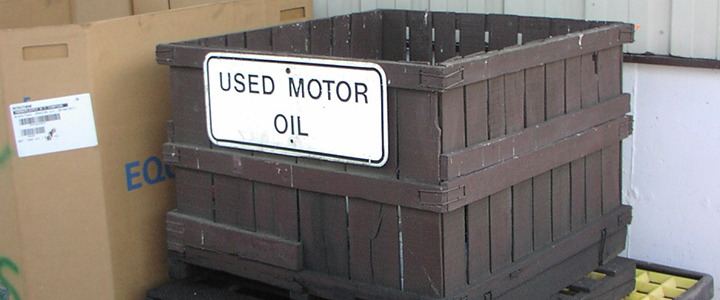
May 2021: Attention DIY Oil Changers: Don’t Be Slick With Your Used Oil
Many New Hampshire residents choose to perform their own oil changes on personal vehicles and other motorized equipment. Do-It-Yourself (DIY) oil changers generate quite a bit of used oil, but how many know what to do with the used oil afterward or the importance of disposing of it properly?
It takes only one pint of oil to produce a one-acre slick on surface water, which may kill plants, fish and other wildlife. One quart of oil may contaminate 250,000 gallons of groundwater and make it unsafe to drink. After use, used motor oil may contain a number of contaminants, including metals and organic chemicals. It is important to properly manage your used oil during and after the oil change in order to prevent contamination of surface water and groundwater. When performing your oil changes, make sure you do it over an impervious surface (a surface that does not allow water or other liquids to percolate through, such as pavements) in case there is a spill and sturdy/compatible containers should always be used to collect the oil that is being drained.
After the oil change, the used motor oil should not be disposed of in the trash or on the ground where it may eventually contaminate drinking water supplies. DIY used motor oil can be recycled or reused. One gallon of used oil can be re-refined into 2.5 quarts of recycled lubricating oil, whereas it takes 42 gallons of crude oil to produce this same amount of virgin lubricating oil. When meeting the proper specifications, used oil can also be efficiently used as fuel in approved boilers or furnaces.
Here are some easy steps to properly dispose of your used oil after performing an oil change:
- Carefully pour the used oil into a suitable recycling container. You may purchase specially designed containers at an automotive store, or reuse a sturdy, clean (preferably clear) container with a closeable lid. Plastic milk jugs with screw caps work well.
- Label the container “Used Oil.” Do not mix any other wastes – such as paint thinners, gasoline or antifreeze – with the used oil. This will affect the recyclability of the oil and may present a safety hazard.
- Take the filled containers to a collection center for proper recycling:
- Most transfer stations have a dedicated storage area for used oil. The transfer station will either use the oil for on-site heating or send it out for recycling. A list of transfer stations collecting DIY used oil can be found here: Municipalities Collecting Household Generated Used Oil.
- Used motor oil may also be collected at a municipal household hazardous waste collection day. For more information, dates and locations contact your local municipality.
- Some auto parts stores and quick oil change facilities will often accept used oil from do-it-yourselfers. A list of businesses that may collect used oil can be found here: Businesses Collecting Household Generated Used Oil. (Always call ahead of time before bringing your used oil to one of these businesses.)
- If you have larger volumes of used oil, you may need to bring your oil to the transfer station in batches. Most towns place limits on the amount of oil you can drop off at one time.
Note: When determining where to bring your DIY used oil always call ahead; used oil collection policies are subject to change at any time. These disposal options are only for do-it-yourselfers. If you are a business, visit the NHDES Used Oil webpage for further information on disposal and recycling options.
What to do with the used oil filter? Check with your local transfer station, as most transfer stations will also collect used oil filters and recycle them. If your transfer station does not accept used oil filters, then there are two options. First, you could dismantle the filter and recycle the metal and dispose of the filter portion, or second, you can dispose of the entire filter with your regular trash. We recommend that oil filters be drained at or above room temperature for at least 12 hours to remove the maximum amount of oil possible.




